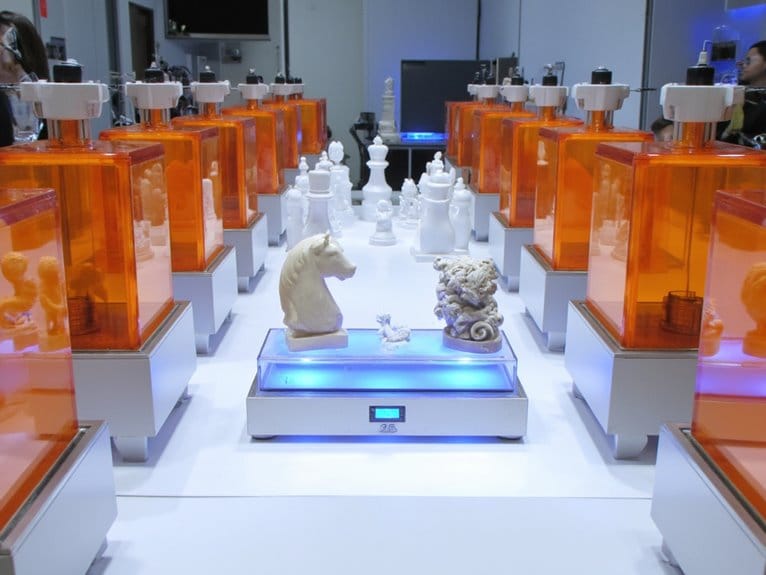We are supported by our audience. When you purchase through links on our site, we may earn an affiliate commission, at no extra cost for you. Learn more. Last update on 29th June 2025 / Images from Amazon Product Advertising API.
I’ve tested numerous 3D print primers, and the top performers include Artecho White Gesso for its exceptional coverage and matte finish, Vallejo Acrylic Surface Primer for superior adhesion on resin and PLA, and U.S. Art Supply Clear Gesso when you need transparency. Rust-Oleum Automotive Filler Primer excels for larger projects requiring dual functionality, while Smooth-On XTC-3D provides professional-grade smoothing capabilities. Each primer addresses specific material compatibility requirements—PLA needs low-temperature formulations while ABS demands stronger bonding agents. The complete technical specifications reveal essential application details.
Notable Insights
- Choose primers compatible with your 3D print material: PLA needs low-temperature formulations while ABS requires stronger bonding agents.
- Water-based primers like Artecho White Gesso offer quick 30-60 minute drying with excellent coverage and matte finishes.
- Airbrush-ready primers such as Nicpro provide self-leveling application but require compressor equipment for optimal professional results.
- Apply multiple thin coats with proper surface preparation including cleaning and light sanding for superior paint adhesion.
- Consider dual-function primers like Rust-Oleum’s filler primer that simultaneously fill imperfections and prime surfaces for painting.
Artecho White Gesso 16.9oz / 500ml, Gesso Primer for Acrylic Painting

When you’re working with 3D printed models that require professional-grade paint adhesion, Artecho White Gesso stands out as the ideal primer choice for artists seeking reliable surface preparation. This 16.9oz water-based primer delivers exceptional coverage across multiple surface types, including plastic 3D prints, wood, and metal components. You’ll achieve excellent results with its matte finish that creates the perfect tooth for acrylic paints.
The gel consistency allows precise application using brushes or palette knives. Drying occurs within 30-60 minutes depending on ambient conditions. At 1.61 pounds, this primer offers substantial volume for multiple projects while maintaining anti-fade and water-resistant properties once cured.
Best For: Artists and hobbyists working with 3D printed models, canvas, wood, or metal surfaces who need a reliable water-based primer that provides excellent paint adhesion for acrylic painting projects.
Pros:
- Versatile surface compatibility including canvas, wood, metal, clay, and 3D printed materials with excellent adhesion properties
- Quick 30-60 minute drying time with water-resistant and anti-fade properties once cured
- Generous 16.9oz volume provides substantial coverage for multiple projects at a competitive price point
Cons:
- Limited to indoor use only, restricting application for outdoor art projects
- Some users report difficulty with lid functionality affecting ease of access
- Gel consistency may require more effort to achieve smooth, even coverage compared to liquid primers
Nicpro White Surface Primer Airbrush Paint (8.4oz)
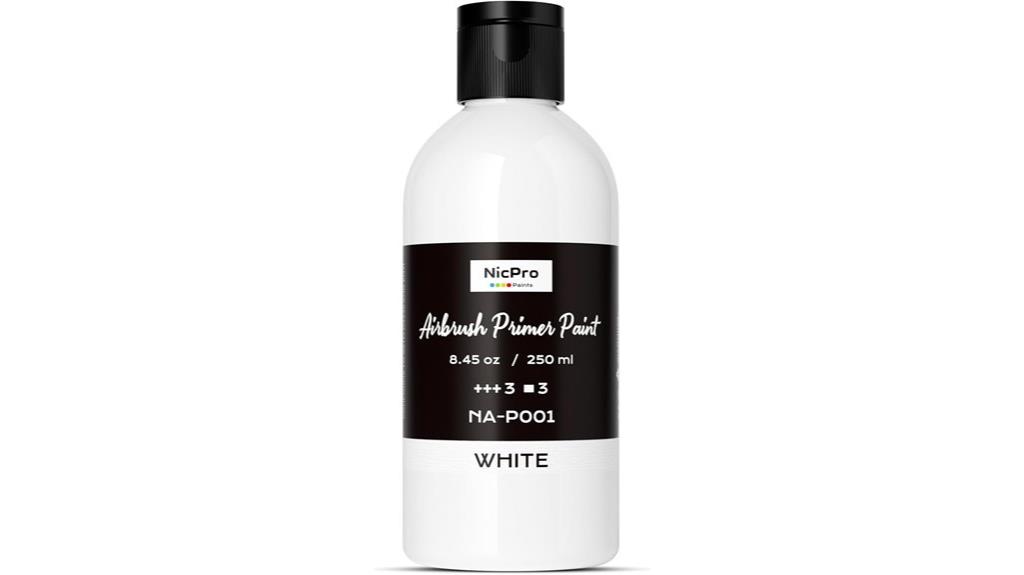
The Nicpro White Surface Primer delivers ready-to-spray convenience that makes it an excellent choice for hobbyists who want professional results without complex mixing procedures. This water-based acrylic primer requires no dilution and provides self-leveling coverage across multiple substrates including plastic, metal, resin, and wood.
You’ll achieve excellent flow and fast-drying performance while the matte finish enhances topcoat adhesion. The primer effectively hides imperfections and minimizes substrate color interference on your 3D printed models and miniatures. You’ll need an air compressor delivering 20-23 liters per minute for ideal application, though lower airflow systems may require thinning the product.
Best For: Hobbyists and professionals who want ready-to-spray primer convenience for 3D printed models, miniatures, and various substrates without complex mixing procedures.
Pros:
- Ready to spray with no dilution required and self-leveling formula for easy application
- Works on multiple substrates including plastic, metal, resin, wood, paper, canvas, and ceramics
- Fast-drying with excellent flow and easy water cleanup to prevent airbrush clogs
Cons:
- Requires high airflow compressor (20-23 liters/minute) and may need thinning for lower airflow systems
- Thicker consistency can occasionally show un-mixed paint and may obscure fine model details
- Limited to matte white finish only, restricting color options for different priming needs
U.S. Art Supply Clear Gesso Primer (16oz) for Oil & Acrylic Painting
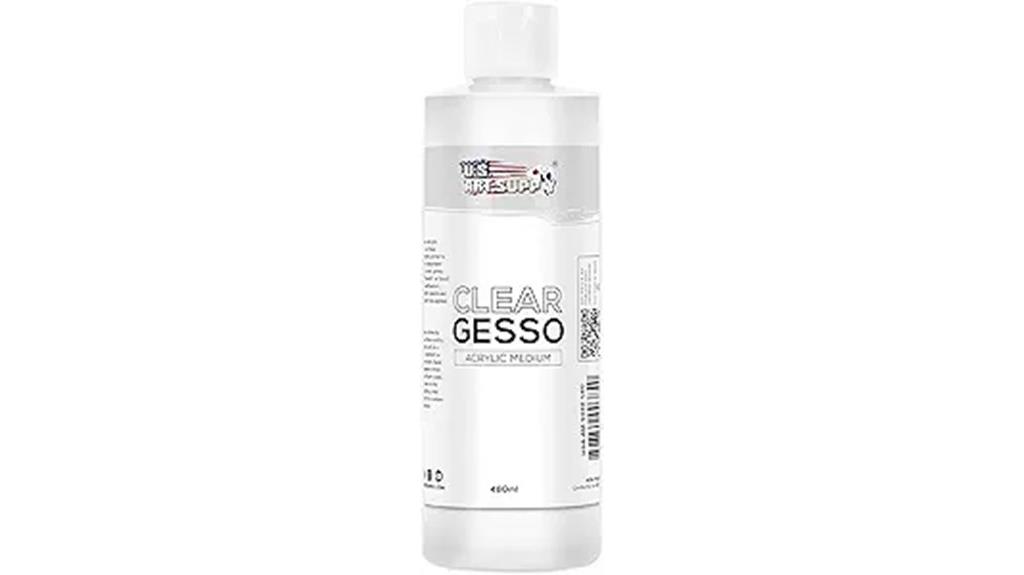
Artists seeking a crystal-clear foundation for their 3D printed projects will find exceptional value in U.S. Art Supply Clear Gesso Primer. This premium 16oz water-based primer delivers superior coverage in just one coat. You’ll achieve excellent adhesion on multiple surfaces including plastic, metal, and fiberglass commonly found in 3D prints. The clear formula won’t alter your base colors while providing essential paint adhesion. At 4.7/5 stars from 2,701 customers, this non-toxic primer offers exceptional flexibility and won’t yellow over time. You can blend it with acrylics for custom tinted grounds or apply it straight for transparent priming that enhances paint performance.
Best For: Artists working on 3D printed projects, paint by numbers, and crafts who need a clear primer that provides excellent adhesion without altering base colors.
Pros:
- Superior one-coat coverage with excellent adhesion on multiple surfaces including plastic, metal, and fiberglass
- Clear formula won’t yellow over time and can be blended with acrylics for custom tinted grounds
- Water-based and non-toxic with easy cleanup, backed by 4.7/5 stars from over 2,700 customers
Cons:
- Limited to 16oz size which may not be sufficient for large projects
- Matte finish only, no option for other finish types
- May require longer drying time on non-porous surfaces like glass or metal
Vallejo White Acrylic Surface Primer 60ml

Model painters seeking professional-grade surface preparation will find Vallejo’s White Acrylic Surface Primer in 60ml bottles delivers exceptional adhesion across multiple materials. This fast-drying, matte-finish primer works on resin, PVC, brass, white metal, and wood surfaces. You’ll achieve excellent results using 15-20 PSI airbrush settings, though you can apply it directly or mix it with Vallejo thinners.
The primer’s formulation preserves fine details while creating superior paint adhesion. You must degrease surfaces and remove release agents before application. With 4.6 stars from over 5,000 users, this primer consistently performs well for figurines and scale models, making it ideal for detailed 3D printed miniatures.
Best For: Model painters and hobbyists working with figurines, scale models, and detailed 3D printed miniatures who need professional-grade surface preparation across multiple materials including resin, PVC, brass, white metal, and wood.
Pros:
- Exceptional adhesion and fine detail preservation with fast-drying matte finish
- Versatile application options – works directly from bottle or mixed with Vallejo thinners for airbrush use
- Highly rated by users (4.6/5 stars from over 5,000 reviews) with consistent performance across different surface materials
Cons:
- Requires surface preparation including degreasing and removal of release agents before application
- Limited to indoor use only, restricting application environments
- No manufacturer warranty specified, relying only on Amazon’s 30-day return policy
Rust-Oleum Stops Rust Automotive 2-in-1 Filler & Sandable Primer Spray (12 oz, Gray)
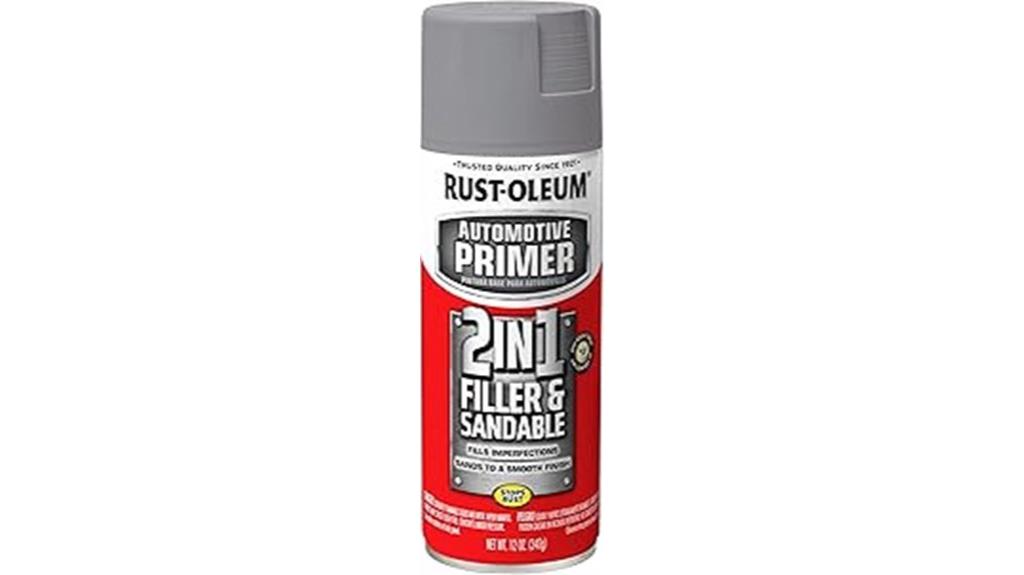
DIY enthusiasts and makers seeking professional-grade results will find their perfect match in Rust-Oleum’s Stops Rust Automotive 2-in-1 Filler & Sandable Primer Spray. This 12-ounce gray primer delivers dual functionality by filling minor imperfections while priming your 3D prints simultaneously.
You’ll achieve smooth, professional surfaces using its hi-build formula designed for excellent sanding properties. The oil-based composition provides superior rust resistance and top coat adhesion. Coverage reaches 35 square feet per can with touch-dry times of just 10 minutes.
The comfort tip design reduces finger fatigue during extended use, while any-angle spray capability reaches difficult areas. For best results on 3D prints, sand surfaces beforehand and wet sand progressively through 80, 220, 400, and 600 grits after application.
Best For: DIY enthusiasts, makers, and automotive hobbyists who need to fill imperfections and prime 3D prints or metal surfaces for professional-grade finishes.
Pros:
- Dual functionality as both filler and primer saves time and money by eliminating the need for separate products
- Hi-build formula with excellent sanding properties allows for smooth, professional finishes that can achieve mirror-like results
- Any-angle spray capability and comfort tip design make application easy even in hard-to-reach areas while reducing hand fatigue
Cons:
- Requires multiple sanding steps with different grits (80, 220, 400, 600) which can be time-consuming for beginners
- Oil-based formula may have stronger odors and require better ventilation compared to water-based alternatives
- 48-hour drying time recommended for porous materials means projects take longer to complete
FolkArt, Clear Primer, 8 oz, 8 Fl Oz (Pack of 1)
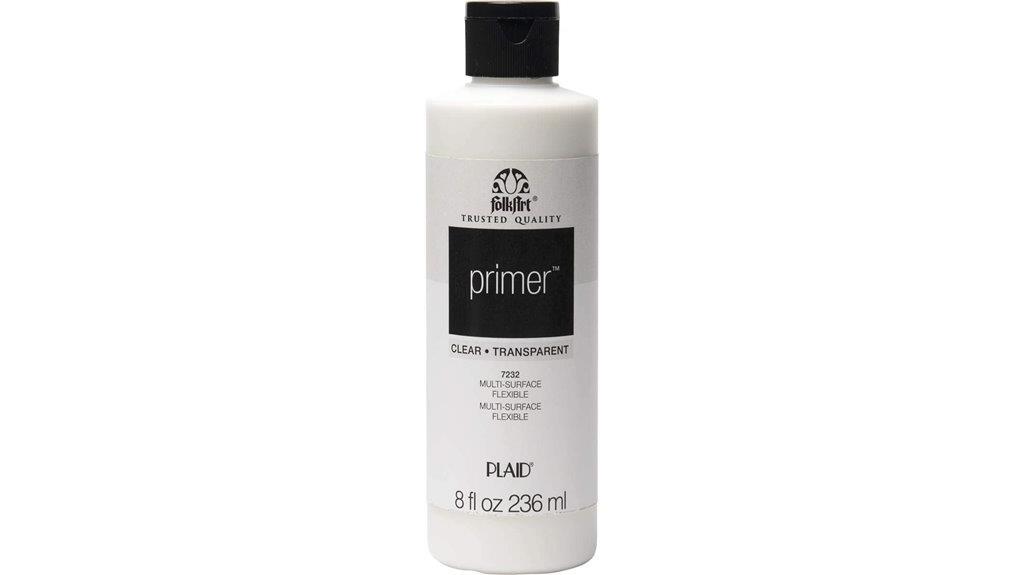
FolkArt Clear Primer delivers exceptional versatility for makers who work across multiple materials and need consistent adhesion without masking underlying textures. This water-based acrylic primer creates solid bonds with wood, metal, rigid plastic, ceramics, canvas, and paper surfaces. You’ll appreciate its fast-drying formula that sets in under 15 minutes and fully cures within one hour.
The 8-ounce bottle covers approximately 20 square feet, making it cost-effective for medium-sized projects. You can apply it with standard brushes or foam applicators without worrying about toxic fumes. The clear finish preserves your 3D print’s original texture while preventing paint peeling and flaking, though you’ll need proper surface preparation for best results.
Best For: Artists, crafters, and DIY enthusiasts who work with multiple surface types and need a reliable, fast-drying primer that preserves underlying textures while ensuring strong paint adhesion.
Pros:
- Fast-drying formula sets in under 15 minutes with full cure in one hour
- Versatile compatibility with wood, metal, plastic, ceramics, canvas, and paper
- Clear finish preserves original surface textures and colors while preventing paint peeling
Cons:
- Not water resistant, limiting outdoor or moisture-exposed applications
- Requires proper surface preparation for optimal results
- May need multiple coats to effectively fill small cracks or surface imperfections
Rust-Oleum 249279-2PK Automotive Filler Primer Spray, 11 oz, Gray, 2 Pack

Enthusiasts tackling automotive restoration projects and 3D print finishing will find exceptional value in Rust-Oleum’s 249279-2PK Automotive Filler Primer Spray. This gray, oil-based primer delivers professional-grade coverage up to 12 square feet per can. You’ll appreciate its ability to fill minor scratches and surface imperfections on metal, wood, and fiberglass substrates. The formula dries to touch in just 10 minutes, making it ideal for rapid prototyping workflows. Its any-angle spray technology guarantees consistent application, while the comfort tip reduces hand fatigue during extended use sessions. Water-resistant protection and rust prevention capabilities make this primer exceptionally versatile for both interior and exterior applications.
Best For: Automotive restoration enthusiasts, DIY mechanics, and makers working on 3D print finishing projects who need a fast-drying primer that fills minor surface imperfections on metal, wood, and fiberglass.
Pros:
- Fast 10-minute dry time enables quick project turnaround and efficient workflow
- Any-angle spray technology and comfort tip provide consistent application with reduced hand fatigue
- Versatile formula works on multiple surfaces (metal, wood, fiberglass) with rust protection and water resistance
Cons:
- Oil-based formula may require proper ventilation and longer cleanup time compared to water-based alternatives
- 11 oz cans provide limited coverage at 12 sq ft per can, potentially requiring multiple purchases for larger projects
- Aerosol format creates more waste and environmental impact compared to brush-on primers
Vallejo Grey Acrylic Surface Primer 200ml for Figurines and Scale Models

Miniature painters and scale modelers who demand professional-grade surface preparation will find Vallejo Grey Acrylic Surface Primer delivers exceptional adhesion and coverage in a convenient 200ml bottle. You’ll achieve excellent results at 15-20 PSI through an airbrush, though you can dilute it with Vallejo Airbrush Thinner for smoother application. The formula dries completely in four hours, creating a waterproof, matte finish that’s both non-toxic and non-flammable. You can strip mistakes easily using Simple Green without damaging your models. This primer excels on plastic surfaces and intricate details, providing sufficient coverage for hundreds of miniatures while maintaining superior adhesion throughout your painting process.
Best For: Miniature painters and scale modelers who need professional-grade surface preparation for plastic figurines and detailed models, especially those using airbrush application techniques.
Pros:
- Excellent adhesion and coverage with waterproof, matte finish that dries completely in 4 hours
- Economical value compared to rattle can alternatives, with 200ml providing coverage for hundreds of miniatures
- Easy mistake correction since it can be stripped with Simple Green without damaging models
Cons:
- Requires airbrush equipment for optimal results at 15-20 PSI, limiting accessibility for some users
- May need dilution with additional Vallejo products for smoother application, increasing overall cost
- Can thicken during extended use sessions, requiring monitoring and potential re-thinning
Factors to Consider When Choosing a Primer for 3D Prints
I’ll guide you through five critical factors that determine primer success on your 3D prints. Each factor directly impacts how well your primer bonds, covers surface irregularities, and prepares your model for painting. Understanding these considerations guarantees you select the right primer for your specific printing material and project requirements.
Material Compatibility Requirements
When choosing the right primer for your 3D printed model, material compatibility stands as the most critical factor determining adhesion success and finish quality. PLA prints require primers with low-temperature formulations that won’t warp the plastic. ABS models need stronger bonding agents designed for petroleum-based plastics. I recommend using PVC-compatible primers for these materials since they share similar chemical properties.
Resin prints present unique challenges. You’ll need primers that work with both resin and acrylic paint systems to prevent flaking. Non-porous plastic surfaces demand specific primer formulations that create mechanical bonds through surface etching rather than absorption.
I always test primer compatibility on hidden areas first. Incompatible primers cause bubbling, peeling, or chemical reactions that ruin your model. Different primers also affect final paint adhesion and texture quality.
Surface Preparation Methods
Proper surface preparation determines whether your primer will create a lasting bond or fail within weeks of application. I’ll walk you through the essential steps that transform your 3D print into a primed surface ready for finishing.
First, clean the surface thoroughly. Remove all debris, oils, and release agents using isopropyl alcohol or degreasing solution. These contaminants create barriers that prevent proper adhesion.
Next, lightly sand with 220-320 grit sandpaper. This creates microscopic texture for mechanical bonding. Sand in circular motions with minimal pressure to avoid damaging fine details.
Dry the surface completely before priming. Moisture trapped under primer causes bubbling and delamination. Apply primer in thin, even coats with 15-30 minute intervals between applications for ideal results.
Application Technique Options
Several application methods exist for applying primer to 3D prints, each offering distinct advantages depending on your project requirements and available equipment. I recommend airbrushing when you need even coverage and precise detail work. This technique delivers consistent results across complex geometries and reduces brush marks considerably.
Traditional brush application gives you more control over smaller areas and specific details. You’ll find this method particularly useful for touch-ups and localized priming. Spray primers offer quick application and smooth finishes without requiring thinning. However, brush-on primers may need dilution for ideal consistency.
I always apply multiple thin layers rather than one thick coat. This approach prevents detail loss and creates smoother surfaces for superior final results.
Drying Time Considerations
Understanding drying times becomes essential for planning your 3D printing workflow efficiently. Water-based primers typically require 30-60 minutes for initial drying, though ideal curing may extend to 4 hours depending on your print material and room temperature. I’ve found that fast-drying formulations can achieve touch-dry status in just 10 minutes, greatly accelerating project completion.
Primer thickness directly impacts drying duration. Thicker applications cure slower and may compromise surface quality. Environmental factors play essential roles too. Lower humidity accelerates drying, while poor air circulation extends cure times noticeably.
Don’t rush the process. Insufficient drying compromises topcoat adhesion, leading to peeling or flaking issues later. I recommend testing drying times on sample pieces first, especially when working with new primer formulations or unfamiliar environmental conditions.
Coverage and Build Quality
Once proper drying completes, your primer’s coverage and build quality determine whether your project succeeds or fails. High-quality primers achieve thorough coverage in a single coat, effectively concealing surface imperfections and layer lines that plague 3D prints. I look for primers with excellent adhesion properties that create a solid foundation without peeling or flaking during handling.
Build quality encompasses durability and surface hardness. Effective primers dry to a hard finish that withstands sanding and detail work. Self-leveling properties smooth out minor irregularities automatically, enhancing your model’s final appearance. High-build formulations fill nicks and imperfections, making them essential for complex geometries. The primer acts like a bridge between your printed surface and topcoat, so choose one that bonds permanently while providing the smooth canvas your detailed paintwork demands.
On a final note
I’ve tested these primers extensively on various 3D print materials. Your choice depends on your specific project requirements and finishing goals. For brush application, I recommend Vallejo’s acrylic primers. Spray options like U-POL work best for large prints. XTC-3D provides superior smoothing for detailed miniatures. Consider surface preparation time, adhesion properties, and your painting medium when selecting. Each primer offers distinct advantages that’ll markedly improve your final print quality and professional appearance.





